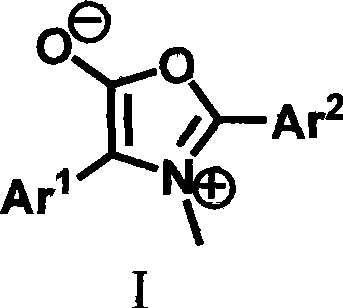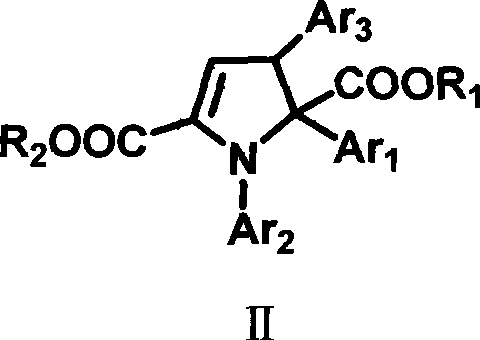Method for preparing dihydro pyrrole derivates
A technology of dihydropyrrole and derivatives, applied in the direction of organic chemistry and the like, can solve the problems of unsuitability for industrialization, inconvenient operation, and difficult to obtain raw materials, and achieves the effects of high reaction yield and safe and simple operation.
- Summary
- Abstract
- Description
- Claims
- Application Information
AI Technical Summary
Problems solved by technology
Method used
Image
Examples
Embodiment 1
[0030] Dissolve (E)-2-oxo-4-p-chlorophenyl-3-butenoic acid methyl ester (1mmol), aniline (1.2mmol) and rhodium acetate (0.01mmol) in toluene (6mL) to form a reaction system , Methyl phenyldiazoacetate (1.2 mmol) was dissolved in 3 mL of toluene to form a solution, and this solution was slowly added dropwise to the reaction system within 1 hour at 45°C. After the dropwise addition, the reaction solution was cooled to room temperature, 10 mL of toluene and citric acid monohydrate (0.2 mmol) were added, and the reaction mixture was refluxed with water for 4 hours through a water separator, the reaction solution was cooled to room temperature, and the solvent was evaporated under reduced pressure , the crude product was obtained, and the crude product was subjected to column chromatography (ethyl acetate:petroleum ether=1:70~1:40) to obtain the corresponding dihydropyrrole derivative with a yield of 75%.
Embodiment 2
[0032] Dissolve (E)-2-oxo-4-m-bromophenyl-3-butenoic acid methyl ester (1mmol), aniline (1.2mmol) and rhodium acetate (0.01mmol) in toluene (6mL) to form a reaction system , methyl phenyldiazoacetate (1.2 mmol) was dissolved in 3 mL of toluene to form a solution, and this solution was slowly added dropwise to the reaction system within 1 hour at 45°C. After the dropwise addition, the reaction solution was cooled to room temperature, 10 mL of toluene and citric acid monohydrate (0.2 mmol) were added, and the reaction mixture was refluxed with water for 3 hours through a water separator, the reaction solution was cooled to room temperature, and the solvent was evaporated under reduced pressure , to obtain a crude product, and the crude product was subjected to column chromatography (ethyl acetate:petroleum ether=1:70~1:40) to obtain the corresponding dihydropyrrole derivative with a yield of 70%.
Embodiment 3
[0034] Dissolve (E)-2-oxo-4-p-nitrophenyl-3-butenoic acid methyl ester (1mmol), aniline (1.2mmol) and rhodium acetate (0.01mmol) in toluene (6mL) to form a reaction system, methyl phenyldiazoacetate (1.2 mmol) was dissolved in 3 mL of toluene to form a solution, and this solution was slowly added dropwise to the reaction system within 1 hour at 45°C. After the dropwise addition, the reaction solution was cooled to room temperature, 10 mL of toluene and citric acid monohydrate (0.2 mmol) were added, and the reaction mixture was refluxed with water for 3 hours through a water separator, the reaction solution was cooled to room temperature, and the solvent was evaporated under reduced pressure , the crude product was obtained, and the crude product was subjected to column chromatography (ethyl acetate:petroleum ether=1:70~1:20) to obtain the corresponding dihydropyrrole derivative with a yield of 84%.
PUM
 Login to View More
Login to View More Abstract
Description
Claims
Application Information
 Login to View More
Login to View More - Generate Ideas
- Intellectual Property
- Life Sciences
- Materials
- Tech Scout
- Unparalleled Data Quality
- Higher Quality Content
- 60% Fewer Hallucinations
Browse by: Latest US Patents, China's latest patents, Technical Efficacy Thesaurus, Application Domain, Technology Topic, Popular Technical Reports.
© 2025 PatSnap. All rights reserved.Legal|Privacy policy|Modern Slavery Act Transparency Statement|Sitemap|About US| Contact US: help@patsnap.com



